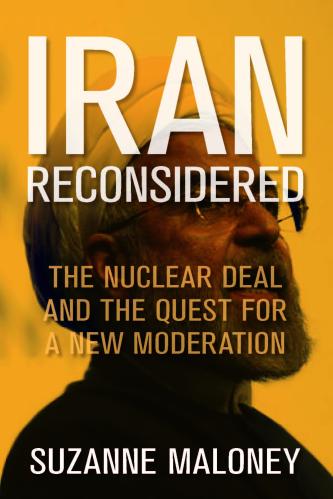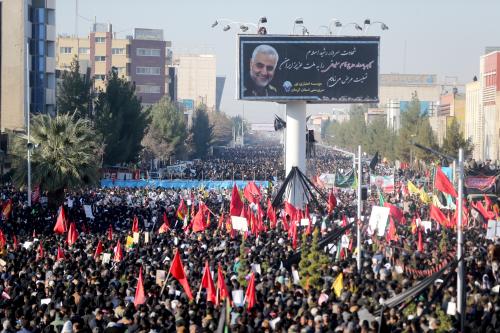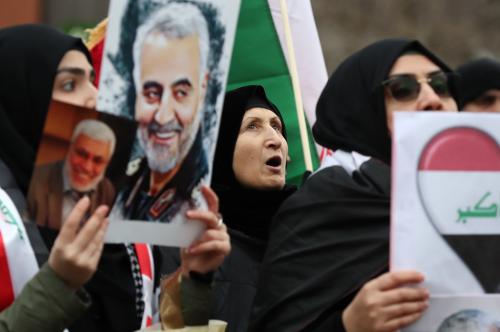Writing in the Washington Post, Alice Friend, Mara Karlin, and Loren DeJonge Schulman argue that “no matter the president, bad military options should not land on his desk. We may have been lucky to ratchet down tensions with Iran. We shouldn’t have to rely on luck next time.”
Sending the U.S. military to use force is among the most consequential decisions presidents can make. Matters may get out of control even with the most careful and deliberate planning. Skipping such steps shows callous disregard for American lives and interests. And there is overwhelming evidence in the past week that President Trump instigated an escalation cycle with an American enemy without such consideration. According to multiple news reports, policymakers gave Trump the option of killing Qasem Soleimani as one of several choices, perhaps hoping that including such a dramatic measure would push him toward a middle course; instead, he went for it, reportedly with little forethought or preparation. Our national security system is not meant to function that way.
Instead of holding a tightly managed, inclusive debate in the Situation Room, Trump made one of the most dangerous choices of his presidency among a tiny group at Mar-a-Lago. Such decisive moments are usually preceded by hundreds of people spending countless hours in dingy government offices and conference rooms, building PowerPoint slides and questioning lawyers. These individuals create the parameters and permutations of what the decision-makers consider. They identify the possible options, vetting their likely operational, diplomatic, economic and other effects. That work enables the commander in chief to make wrenching decisions about his military options wisely.
At least, that is how decisions are supposed to be made, and how we helped leaders make them when we worked in government. Bad options, considered with little serious deliberation on an unnecessarily rapid timeline, should never get to the president in the first place.
Like the broader system of government, which is designed around cumbersome checks and balances to prevent impulsive action, the traditional decision-making process for employing military force is ponderous. These steps frustrate some who view military advice as best when it’s direct and unadulterated, but they are supposed to ensure that the president chooses only from options that have been examined thoughtfully by experts in a variety of relevant areas. And the process is meant to consider all possible reactions with due preparation. To do otherwise may come at a toll of blood and treasure, credibility and certainty.
Since Soleimani’s death, many foreseeable consequences have unfolded. Iran threatened retaliation and took at least two such actions, first announcing the death of the 2015 nuclear agreement, then launching a ballistic missile attack on Iraqi bases where U.S. forces are deployed. The Iranian public — probably under some pressure — rallied around its government, expressing anger in massive street demonstrations. Elements of the Iraqi government also signaled that the U.S. strike has imperiled that bilateral relationship, with the parliament voting to expel American forces from the country. In his first public address on the crisis Wednesday, Trump suggested that he will pause further military action, but the American position in the Middle East is almost certainly worse now, with little benefit to show for the strike.
Soleimani and his campaign of violence were provocative and merited an American response. But killing him, and doing it in Iraq, needlessly escalated the situation. Any standard Defense Department and interagency process of vetting options would have seen the threats, counterthreats and missile launches coming and recommended against it — which we know because two very different administrations rejected targeting the general. But many press accounts say no such process was followed under Trump.
In our combined 25-plus years in the Pentagon and the White House, use-of-force and even show-of-force decisions created some of the tensest moments between civilian and military leaders, revealing differences in approaches and assumptions. We saw controversies over the U.S. naval presence in the South China Sea, counterterrorist strikes in areas outside active hostilities across the Middle East and Africa, and troop deployments in Afghanistan. Interactions can be so fraught, and secrecy so important, it was often tempting for both sides to limit the number of people involved or go directly to those with decision-making authority. With Soleimani’s death, we don’t know whether civilians cut out military planners or if military officials took shortcuts in the process. Regardless, whatever truncated steps led to the choice to kill him had alarming results.
In our experience, any serious process to consider military force should include six key criteria.
First, the use of force must be consistent with international and domestic law. Deliberately targeting civilians or cultural sites, for example, should be off the table — and the Pentagon ruled those options out after Trump suggested them this past week.
Possible courses of action should be aligned to the broadest strategic objectives. The Soleimani strike was a tactical success, but it damaged the goals of countering the Islamic State, stabilizing Iraq and getting Iran to the negotiating table; it also put U.S. personnel across the region at risk. Before the raid that killed Osama bin Laden in 2011, planners considered many parallel matters: the risk to U.S. service members; the possibility of civilian casualties; the likely diplomatic fallout with Pakistan and what that might mean for the war in Afghanistan; the legal authorities and implications; the domestic political cost if the raid resulted in American casualties, failed or both; and how Congress would react to all of those considerations.
Operations must be proportional to the security context. Killing one of the most senior Iranian military leaders, even with his lengthy list of despicable crimes and ostensible involvement in imminent threats, was an extreme response to the staged protests against the U.S. Embassy in Baghdad and the rocket attack on an Iraqi base that killed one American. Killing Soleimani in response to these acts — particularly without providing any public evidence of an impending attack against Americans (though the administration has repeatedly insisted that this is what it was trying to prevent) — skipped tens of rungs on the escalation ladder.
Military actions must also be operationally feasible. Political leaders may ask for proposals that belie the laws of space and time because of a well-intentioned but fundamental misunderstanding of military capability. The U.S. military cannot simply find and kill a target anywhere in the world at any time using drones, a demand sometimes made by policymakers. Research by one of us found that many senior officials involved in drone policy underestimate the cost and logistics and overestimate drones’ availability, capabilities and range.
Options for strikes should be real options. Reportedly, whoever drafted the president’s briefing slides used the Goldilocks paradigm — presenting options that were too mild, too extreme and one that was just right. In such frameworks, most of the options are meant to be throwaways; these typically receive much less attention and planning than the preferred option does. Such frameworks are deceptive and dangerous: The Soleimani strike was never meant to seem best.
President Barack Obama faced this paradigm during the Afghanistan strategic review in 2010, when the military leadership offered widely varying recommendations for troop levels. During the George W. Bush administration, former senior Pentagon official Peter Rodman lamented how difficult it was to get the military to tee up meaningful and discrete options besides “do nothing and thermonuclear war.” This kind of advice presumes that the decision-makers are in on the gag; they aren’t always.
Finally, options must be politically informed. Obama’s unwillingness to intervene in Syria, for example, was rooted in his belief that the public wouldn’t support it. When Congress signaled its resistance as well, his view was solidified.
Inside the Pentagon, by statute, the chairman of the Joint Chiefs of Staff is responsible for the development of military analysis, options and plans to share with the defense secretary and the president as he sees fit. In reality, military advice is not just one individual’s best ideas but a massive and complex process that engages hundreds of military and civilian experts. Those people generate and vet the options and flag political considerations, calculating how to best mitigate risk and coordinate with allies.
Yet it appears that the tight circle at Mar-a-Lago involved in making the decision to kill Soleimani — mainly the secretaries of defense and state — neglected many of these key elements, as the convoluted messaging, lack of preemptive mitigating actions and failure to inform close U.S. allies, let alone members of Congress, demonstrate.
It seems that the national security apparatus skipped crucial steps while deferring to Secretary of State Mike Pompeo’s advocacy. For example, consulting the Commerce Department might have flagged potential oil market impacts; Treasury could have noted the likely market fluctuations; the intelligence community could have offered real-time analysis on threats to U.S. personnel before and after the strike; and the State Department may have requested noncombatant evacuations of Americans from various Middle Eastern hotspots, highlighted the diplomatic fracas with European allies and underscored the need for deft diplomacy to repair the inevitable U.S.-Iraqi government crisis so that killing Soleimani did not cause a rupture.
Instead, Trump reportedly relied on a few advisers for what may be the most consequential foreign policy decision of his presidency. Small-group decision-making limits the imagination and thwarts checks and balances — and it can be dominated by impassioned advocates. The resulting decisions tend to be more about the president’s preferences than about national security interests. Now Trump needs to hear from a broad range of advisers about what might come next.
Of course, with this chaotic administration, lecturing on procedural deliberation from the outside may seem like wishcasting, at best. What, then, can responsible defense and military officials do when the president demands risky options, when the secretary of state inserts himself in the chain of command or the commander in chief publicly threatens war crimes? The answer is not to make post-hoc justifications or to pray that our system survives. The muscles of deliberation have to be exercised. Engaging Congress, which established the authorities that create good military options; reiterating to the troops and the world that the U.S. military follows the rule of law; telling senior commanders that they should not be tempted by those seeking private advice; promoting the secretary of defense as the face of the defense apparatus — these are all useful near-term steps.
No matter the president, bad military options should not land on his desk. We may have been lucky to ratchet down tensions with Iran. We shouldn’t have to rely on luck next time.









Commentary
Why did the Pentagon ever give Trump the option of killing Soleimani?
January 14, 2020